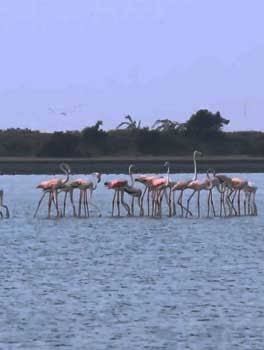
Point Calimere Wildlife Sanctuary

31.10.2023
Point Calimere Wildlife Sanctuary , Daily Current Affairs , RACE IAS : Best IAS Coaching in Lucknow
|
For Prelims: Point Calimere Wildlife Sanctuary,Flora,Fauna,Wildlife Sanctuaries in India |
Why in the news?
Recently, the reservoirs at Point Calimere Sanctuary were desilted and deepened to attract birds.
Important points
- With the migratory season at the peak of the Point Calimere Wildlife and Bird Sanctuary, the forest department is preparing to increase the reservoirs to attract more birds in the coming weeks.
- For the past two months, few migratory birds have been sighted in the Kodiyakarai wetlands due to a dry period without much rainfall compared to previous years.
- Some of the migratory birds seen include Little Stint, Lesser Sand Plover, Marsh Sandpiper, Curlew Sandpiper, Common Greenshank, Common Redshank, Wood Sandpiper, Eurasian Curlew, Painted Stork and Oriental Pratincole.
About Point Calimere Wildlife Sanctuary
- Point Calimere Wildlife Sanctuary was created in 1967 to conserve the blackbuck, an endangered and endemic species of India.
- This sanctuary is located in Nagapattinam district of Tamil Nadu.
- Point Calimere is surrounded by a sandy coast, with brackish marsh and thorny scrub surrounding the backwaters.
- It contains the famous bird sanctuary of Vedaranyam and the Talaiganyar forest.
- In the sanctuary, there are about 60 pounds and 20 artificial water reservoirs under the Vedaranyam forest area.
- Of these, 10 pounds in and around the sanctuary have been desilted and deepened.
- It is bounded by the Bay of Bengal in the east and the Palk Strait in the south.
- At Point Calimere the coast makes a 90° turn.
- It is home to the largest population of blackbuck in South India. Locally called “Veliman”, the blackbuck is endemic to India and is the only representative of the genus Antelope in the country.
- It has been designated as a Ramsar site.
Flora
- It has mangrove, tropical evergreen forest and grassland ecosystems.
- The sanctuary is a unique blend of grasslands, mudflats, backwaters, sand dunes and tropical dry evergreen forests.
- The tropical dry evergreen forest of this sanctuary is considered to be the richest tract in the entire country.
- The grasslands on the southern part of the sanctuary are the natural habitat of the blackbuck.
- Out of 364 species of flowering plants recorded in the sanctuary, 198 species are found to have medicinal properties.
Fauna
- Apart from the blackbuck, other animals in the sanctuary include spotted deer, jackal, bonnet monkey, wild boar, small-nosed fruit-bat, small Indian civet, common mongoose, black tailed hare, feral pony monitor lizard, and star tortoise.
- Among the 103 species of migratory water birds recorded in the sanctuary, the most prominent is the Greater Flamingo. They mostly come from the Rann of Kutch in Gujarat, with some from further afield such as the Caspian Sea and Northern Russia.
- The sanctuary is a regular nesting site of the endangered olive ridley turtle (Lepidochelys olivacea) from January to March. An artificial hatchery for the Olive Ridley turtle has also been established in this sanctuary.
Wildlife Sanctuaries in India
- India currently has 588 wildlife sanctuaries covering 117,230.76 sq km, which is 3.87% of India's geographical area.
- Also, around 150 Wildlife Sanctuaries Protected Area Network covering an area of 16,829 sq.km are proposed in the report.
- India's wildlife sanctuaries are classified as IUCN Category IV protected areas.
- The Wildlife (Protection) Act of 1972 allowed the state government to declare specific areas as wildlife sanctuaries if they were considered to be of sufficient ecological, geomorphological and scenic value.
- The largest number of wildlife sanctuaries in India is located in Andaman and Nicobar (96).
- India's largest wildlife sanctuary is the Rann of Kutch, also known as the Indian Wild Donkey Sanctuary.
- Vedanthangal Bird Sanctuary, in the state of Tamil Nadu in India, is the oldest bird sanctuary. It was established in 1796.
Source: Times of India